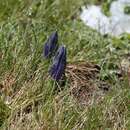ar
الأسماء في صفحات التنقل


Der Alpen-Enzian (Gentiana alpina) ist eine Pflanzenart aus der Gattung der Enziane (Gentiana) in der Familie der Enziangewächse (Gentianaceae).
Der Alpen-Enzian ist eine ausdauernde krautige Pflanze, die nur bis zu 8 Zentimetern erreicht. Die gegenständigen Laubblätter sind gedrängt an der Basis des Stängels angeordnet. Die einfache Blattspreite ist etwa 1 Zentimeter lang und nahezu kreisförmig. Die Blattränder sind knorpelig.
Die Blüten stehen einzeln endständig an den Stängeln. Die zwittrigen Blüten sind radiärsymmetrisch mit doppelter Blütenhülle. Die fünf grünen Kelchblätter sind bis zu etwa der Hälfte ihrer Länge zu einer Kelchröhre verwachsen, die in fünf eiförmigen und zur Basis hin verschmälerten Kelchzähnen endet. Die dunkelblaue Krone ist bei einer Länge von 40 bis 70 Millimetern verkehrt-kegelförmig. Im Kronschlund finden sich grüne Punkte, die Kronlappen sind stumpf und meist gerundet.
Bei Gentiana alpina handelt es sich um einen Hemikryptophyten.
Gentiana alpina findet sich im Südwesten und dem Westen der Mittleren Alpen, den Mittleren Pyrenäen sowie in der Sierra Nevada im Süden Spaniens. Sie ist kalkmeidend und wächst in Höhenlagen von 2000 bis 2600 Metern. Sie findet in den Alpen ihr Optimum in Gesellschaften des Verbands Caricion curvulae.[1]
Die Erstveröffentlichung erfolgte 1779 unter dem Namen Gentiana alpina durch Dominique Villars in Prospectus de l'Histoire des Plantes de Dauphiné, Seite 22. Synonyme für Gentiana alpina Vill. sind Ciminalis alpina (Vill.) Holub, Gentiana acaulis subsp. alpina (Vill.) O.Bolòs & Vigo.[2][3]
Adolf von Kleebsattel, ein Sammelpseudonym für Wolfgang Neukirchner und Erich Becht, schuf das Lied „Blau blüht der Enzian“, das durch Heino zum Millionenseller wurde, und den Titel eines gleichnamigen Spielfilms lieferte.
Der Alpen-Enzian (Gentiana alpina) ist eine Pflanzenart aus der Gattung der Enziane (Gentiana) in der Familie der Enziangewächse (Gentianaceae).
Gentiana alpina (commonly Alpine gentian)[1] is a plant species from the Gentiana genus in the family Gentianaceae.
The Alpine gentian is a perennial herb that grows to only 8 centimetres (3 in). The opposite leaves are crowded at the base of the stem . The simple leaf blade is about 1 centimetre (0.4 in) long and nearly circular. The leaf margins are cartilaginous.
The flowers are individually terminal on the stems. The hermaphrodite flowers are radially symmetric with a double perianth. The five green sepals are fused up to about half their length into a calyx tube, which ends in five ovoid calyx teeth that narrow towards the base. The dark blue crown is an inverted cone with a length of 40 to 70 millimetres (1.6 to 2.8 in). There are green dots in the crown gullet, the crown lobes are blunt and mostly rounded. G. alpina takes a hemicryptophytic form.
Gentiana alpina is found in the south-west and west of the Middle Alps, the Middle Pyrenees and in the Sierra Nevada of southern Spain. It avoids growing in limestone rocks, and grows at elevations of 2,000 to 2,600 metres (6,600 to 8,500 ft). In the Alps, G. alpina typically occur in the Caricion curvulae plant association.[2]
Adolf von Kleebsattel created the song „Blau blüht der Enzian“, which became a bestseller thanks to performances by the musician Heino. The song provided the title of a feature film: Blue Blooms the Gentian.
Gentiana alpina (commonly Alpine gentian) is a plant species from the Gentiana genus in the family Gentianaceae.
Gentiana alpina es una especie del género Gentiana perteneciente a la familia de las gentianáceas.
Es una planta anual. Las hojas se acumulan en la base del tallo con bordes cartilaginosos, de alrededor de 1 cm de largo y casi circular. Las flores son terminales solitarias en los tallos. El cáliz es de color verde con de cinco dientes. La corona es de 40 a 70 mm de largo, cónica y teñida de color azul oscuro.
La especie se encuentra en el suroeste y oeste de los Alpes, Pirineos y Sierra Nevada en el sur de España. Es intolerante al calcio (calcífuga) y crece en altitudes de 2000 a 2600 metros.
Gentiana alpina fue descrita por Dominique Villars y publicado en Prospectus de l'Histoire des Plantes de Dauphiné 22. 1779.[1]
Número de cromosomas de Gentiana alpina (Fam. Gentianaceae) y táxones infraespecíficos: 2n=36[2]
Gentiana: nombre genérico que según Plinio el Viejo[3] y Dioscórides,[4] su nombre deriva del de Gentio, rey de Iliria en el siglo II a. C., a quien se atribuía el descubrimiento del valor curativo de la Gentiana lutea.
alpina: epíteto latino que indica su localización en lugares montañosos.[5]
Gentiana alpina es una especie del género Gentiana perteneciente a la familia de las gentianáceas.
Gentiana alpina
La Gentiane des Alpes aussi appelée Gentiane alpine (Gentiane alpina) est une espèce de plantes herbacées vivaces de la famille des Gentianaceae.
Taille : au maximum 7 cm de haut, elle ne possède pas de tige alors qu'une autre espèce occupant les mêmes milieux, la gentiane acaule en possède une parfois très petite. Les feuilles sont très courtes, assez larges et relativement épaisses. La fleur mesure de 20 à 35 mm de long. Floraison de juin à aout.
Elle se développe dans les pelouses alpines et subalpines sur des sols acides à des altitudes variant de 1 500 à 2 600 m.
Gentiana alpina
La Gentiane des Alpes aussi appelée Gentiane alpine (Gentiane alpina) est une espèce de plantes herbacées vivaces de la famille des Gentianaceae.
Gentiana alpina là một loài thực vật có hoa trong họ Long đởm. Loài này được Vill. mô tả khoa học đầu tiên năm 1779.[1]
Gentiana alpina là một loài thực vật có hoa trong họ Long đởm. Loài này được Vill. mô tả khoa học đầu tiên năm 1779.